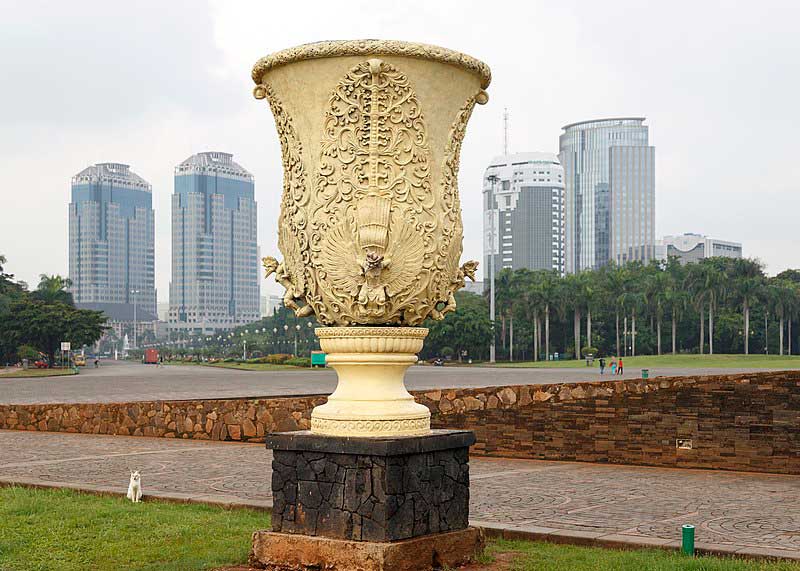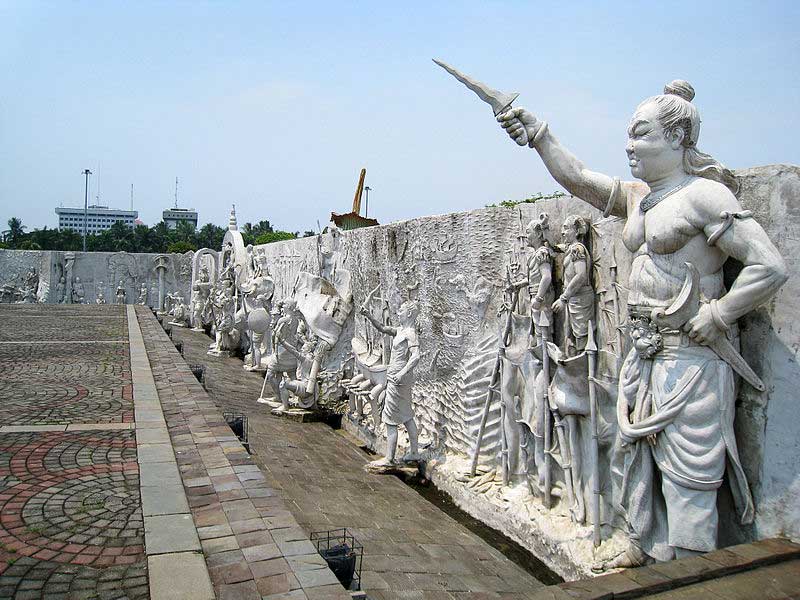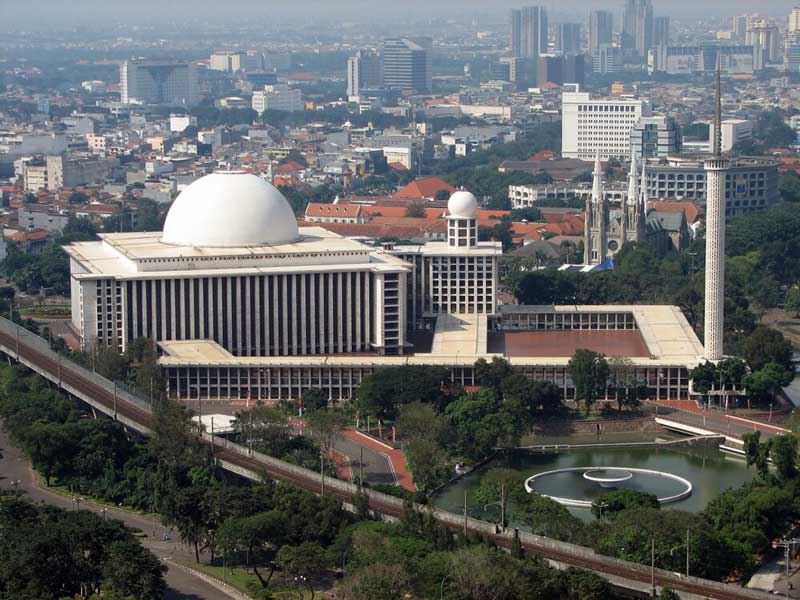
Located in the heart of Jakarta, the capital and largest city of Indonesia, the Merdeka Square, surrounded by several important government buildings, is considered one of the largest squares in the world. With the National Monument at its centre, along with a musical fountain in the western side and a deer enclosure in the southeast corner, the grand square in its 75-hectare space, is more than five times the size of Tiananmen Square in China and 12 times the size of Place de la Concorde in France.
Known for its historical, cultural and architectural importance, the square is also a popular destination for sports and recreation, especially on weekends, a popular location for local fairs and artisan markets and is certainly a leisure destination for enjoying a family picnic, watching the deer roaming among the shady trees in their enclosure or admiring Jakarta from atop the National Monument.

Initially, it was a large open field for herding kerbau or water buffalo and was known as Buffelsveld. Later, when the Dutch East Indies government moved their centre of administration from coastal old Batavia to Weltevreden, now Central Jakarta, Weltevreden had two main squares, namely Buffelsveld and Paradeplaats or Parade ground, which was later renamed Waterlooplein, meaning Waterloo Square and finally, Lapangan Banteng, which literally stands for Bull’s Field.
However, the current square began to take shape in the early 19th century, during the rule of Herman Willem Daendels, when Waterlooplein became the main parade and ceremonial square and the Buffelsveld or buffalo field was renamed Champ de Mars, after the large public greenspace in Paris, due to French influence and used as a military exercise field.


But the name of the square was changed again to Koningsplein or King's square in 1818, a few years after the formation of the United Kingdom of the Netherlands and around the same time the residence of the Governor-General was shifted to a newly built palace, now known as Istana Merdeka. Eventually, the then colonial government built athletic tracks, a stadium and added other sports facilities on Koningsplein for the advancement of sports in the country.
However, the locals fondly called the square Lapangan Gambir, after Uncaria Gambir or Gambier, a climbing shrub, which grows in abundance around the field and with the progress of time it became the location of Pasar Gambir or Gambir Fair, which was held for the first time in 1906 and yearly from 1921, until the Japanese invasion in 1942, a Pasar Malam or Night Market Fair and the festival to commemorate Queen Wilhelmina's birthday in 1906. During the Japanese occupation of Indonesia in 1942, the square was named Lapangan Ikada, the acronym of Ikatan Atletik Djakarta or Jakarta Athletic Bond, which was subsequently changed to Medan Merdeka or Independence Square in 1949, by Sukarno, the first president of Indonesia, serving from 1945 to 1967.

The idea of the National Monument, also known as Monumen Nasional or Monas, the 433 feet (132 m) tall obelisk, topped by a flame, covered with gold foil, standing in the centre of Merdeka Square, was conceived by President Sukarno, who desired that the Indonesian people and the young independent nation should have something to be proud of, a monument to commemorate the struggle for independence. The construction of Monas began on 17 August 1961 with Sukarno ceremonially driving in the first concrete pile and was officially opened to the public on 12 July 1975. The outer yard surrounding the Monas was aesthetically decorated with reliefs of Indonesian history, made from moulded cement, although several of the statues are damaged and have decayed due to weathering. However, for the dignified presence of the monument, the square is now more popular with its nickname Lapangan Monas.

The current design of Merdeka Square is mainly based on the site plan from the 1960s, as a part of the design of the National Monument that incorporated diagonal crossed streets that separated four cardinal parks. Soon after the construction of the National Monument, new buildings began to grow in the southern part of the square and the southern segment became developed into a building complex, while the north, east and west sides of the square remained a park. Nevertheless, the southern section was also occupied by the fairground for Jakarta Fair from 1968 to 1992, while the southwest corner of the south park was used as Taman Ria Jakarta or Jakarta amusement park, which included several exhibition halls, restaurants and nightclubs. Initially, the roads were made of asphalt, which were subsequently changed to French stone pavement in the 1990s. The paved plaza that surrounds the National monument often hosts national events, as well as civil demonstrations. Military parades and float parades, either built on a truck or towed behind one, usually take place during the Jakarta anniversary around 22 June and the independence day commemoration around 17 August, when the flag hoisting ceremonies are held at the north end of the square, during the citywide public anniversaries. Since 2016, national celebrations customarily begin with the departure of replicas of both the national flag and the text of the Proclamation of Independence from the monument and the square, on the route to Merdeka Palace in the morning and returning to the square in the evening.

The Merdeka square consists of two zones. Taman Medan Merdeka zone, spanning from the fences on the outer rim of the park to the pedestrian path around the park with large shady trees, reflecting ponds and fountains, has four parks, which include a bust of Indonesian poet Chairil Anwar, a statue of Indonesian hero Kartini, a deer park, food stalls and a musical fountain. Apart from that, several areas in the zone are used for other activities like football games, jogging, flying kites and family picnics. In contrast, Ruang Agung zone, the grand space to enhance the view of the National Monument, is located from the pedestrian path to the National Monument in the centre, without any big tree or any other visual obstructions, assuring full attention on the national monument. It contains grass fields, stone paved grand plaza, along with a central garden around the monument, filled with colourful flowers and decorative plants and is used for national events like military parades, flag hoisting ceremonies and civic demonstrations.


Merdeka square is the heart of Jakarta and several important government and cultural buildings are located around it, which includes the Merdeka Palace, the National Museum, the National Library, Jakarta City Hall, Istiqlal Mosque and others. The Merdeka Palace, one of six presidential palaces in Indonesia and also known as Istana Gambir and Paleis te Koningsplein during the Dutch colonial periods, is located on the north side of the Merdeka Square, while the National Museum of Indonesia, popularly known as the Elephant Museum or Museum Gajah, after the elephant statue in its forecourt, is located right on the west side. The National Library of Indonesia, the legal deposit library of the country, serving primarily as a humanities library and the Jakarta City Hall, the seat of the Jakarta City Government, housing the office of the governor and the vice governor and the main administrative office, both are located on the south side of the square. Located in the northeast corner of Merdeka Square, the Istiqlal Mosque, which stands for Independence Mosque, was built to commemorate the independence of the country and was opened to the public on 22 February 1978.

Proudly presenting open green spaces with shady trees in the heart of the city, along with well-paved roads winding all around with the National Monument at its centre, along with a museum and surrounded by important buildings, Merdeka square is considered a must-visit attraction in Jakarta to get a glimpse into the city and the rich history of the country, with plenty of other attractions within walking distance.